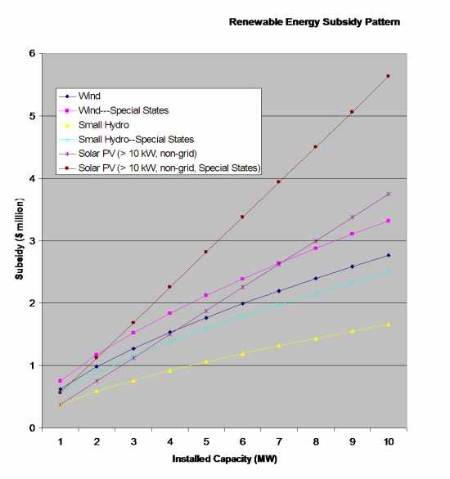Renewable Energy Holds Promising
Future in India
Apr 18, 2008 - Anupam Tyagi
- RenewableEnergyWorld.com
Ghaziabad, India [RenewableEnergyWorld.com]
 |
| Photo: Andy Swapp |
According to the 11th New and Renewable Energy
five-year plan proposed by the government of India,
from 2008-2012 the renewable energy market in India
will reach an estimated US $19 billion. Investments
of US $15 billion will be required in order to
add the approximately 15,000 megawatts (MW) of
renewable energy to the present installed capacity.
The government of India has planned a subsidy support
system of approximately US $1 billion in government
funds. This amounts to adding renewable energy
capacity at 1 Watt per US $1, with potential subsidy
support of US $0.07/Watt.
The Indian government has also set specific targets
for renewable energy: by 2012 it expects renewable
energy to contribute 10% of total power generation
capacity and have a 4-5% share in the electricity
mix. This implies that growth in renewable energy
will occur at a much faster pace than traditional
power generation, with renewables making up 20%
of the 70,000 MW of total additional energy planned
from 2008-2012.
From 2002 to 2007, there was 3,075 MW of renewable
grid-tied power planned, but the actual capacity
addition exceeded 6,000 MW by 2006. A large share
of this was the result of exceptional growth of
wind energy in India. Wind energy is expected to
add more than 10,000 MW of additional capacity
by 2012, followed by small hydro (1,400 MW), co-generation
(1,200 MW) and biomass (500 MW).
In the past five years, the government of India
had withdrawn subsidies for grid-tied solar power
because its costs were not considered viable. Plans
for a 140 MW Integrated Solar Combined Cycle plant
at Mathania, Rajasthan were canceled after an unfavorable
technical and commercial review. But recently this
sector has experienced a turn-around, with new
technologies and manufacturing capacity in India
(See Scaling Up Solar in India.) With the success
of grid-tied solar electricity in other countries,
and new state-level initiatives for feed-in tariffs,
the outlook for this segment is now positive. The
government has set aside US $50 million to subsidize
solar power when its costs match those of small
hydro.
Financial assistance is available in various forms,
such as direct installation subsidy, feed-in tariffs,
tax rebates, and low interest loans. Increasingly
Indians are seeing a shift away from subsidizing
installed capacity and towards subsidizing power
generation with feed-in tariffs and tax rebates.
For example, for wind energy there is an income
tax exemption for 10 years, 80% accelerated depreciation,
sales tax exemption, and excise duty exemption.
Preferential tariffs are being worked out at the
state level. While the new framework for supporting
renewable energy generation is evolving, most of
the direct subsidy has thus far been designed for
installed capacity.
Projects in the states in northeastern part of
India and the hill states of Jammu & Kashmir,
Himachal Pradesh and Uttaranchal currently receive
the best support, with subsidies there 20% to 50%
higher than in other states of India. Some of the
highest direct subsidy rates have been announced
for installation of grid-tied wind and small hydro,
and off-grid solar photovoltaic (PV) projects.
The present subsidy for 1 MW grid-tied wind is
$625,000 and for 1 MW grid-tied small hydro it's
$375,000. See the chart below for more information.
 |
Source: Anupam Tyagi |
The Ministry of New and Renewable Energy has identified
renewable energy R&D as an important factor
for developing this sector. R&D subsidy is
100% of a project's cost in government R&D
institutions, and 50% in the private sector. The
R&D subsidy for the private sector may be enhanced
for initial stages of technologies that have longer
time-horizons.
Subsidy support is for firms with majority Indian
stake. Firms with foreign majority stake can take
advantage of subsidies if they have local Indian
partnersv or if the R&D they provide is at
lower costs and in shorter time than R&D provided
by firms in India. Foreign firms can also received
R&D subsidy support in exceptional cases when
the larger national interest is evident and is
served by that firm. Many Indian firms have foreign
R&D collaborations or financial stakes in foreign
R&D firms.
In the past a significant proportion of allocated
funds have gone underutilized, possibly due to
lack of availability of suitable projects and procedural
delays. One area of concern is the lack of bankable
projects in bagasse-based cogeneration and urban
waste-to-energy space. In these cases, 50% of the
direct subsidy amount will be given upfront, with
the other half being distributed after the completion
of the project.
With maturing technologies and integrated business
models in renewable energy business, the suitability
of projects is likely to improve, resulting in
higher utilization of available government funds
and faster market growth. This has been the case
of wind energy in India. Integrated installation,
operations and repair contracts are common in the
wind energy business. This has provided a viable
and investor-friendly business model.
Thin-film solar production is expected to lead
to the development of PV-based electricity generation.
Technologies in the wind, bio-mass, waste-to-energy
and small hydro markets are at the venture capitalist
stage, waiting for funding to begin commercialization
and scaling up of thier projects.
Policies at state and local levels, like feed-in
tariffs, tax incentives, technical training, financing
mechanisms and revenue recovery can go a long way
in building a successful renewable energy market
in India. Improvements in energy efficiency can
reduce recurring cost of energy using technology
that is often priced even higher than the cost
of renewable energy. This will make investments
in this sector attractive.
Building renewable energy infrastructure also
requires mapping the natural resource base. In
a continuing effort to build the information infrastructure
for renewable energy, GIS (geographic information
systems) mapping of renewable sources will continue
with government funding. In addition, classification
and rating of potential location sites is considered
a strategically important area. To realize the
estimated total potential of 85,000 MW of renewable
energy in India, keeping renewable energy business
in-sync with international standards is important.
Therefore, equipment-related subsidies and incentives
are often made contingent upon meeting international
standards.
The Ministry of New and Renewable Energy in India
has also provided funds for town and city level
renewable energy planning. This local information
infrastructure, comprising of local awareness,
urban design, laws and smooth functioning processes,
is an important step towards integrating renewable
energy into economic life, and improving power
delivery in the last kilometer. In addition to
improving investment opportunities, this may also
bring about greener, better designed and less polluted
cities. With the expected growth in this sector,
the availability of technically trained personnel
may become a hurdle for further growth in the coming
years. Thus, an opportunity exists for educational
and training institutions to introduce new courses,
curricula, and training for students to work in
this emerging job market in urban and rural areas.
Anupam Tyagi is a RenewableEnergyWorld.com Indian
Correspondent based in Ghaziabad, India.